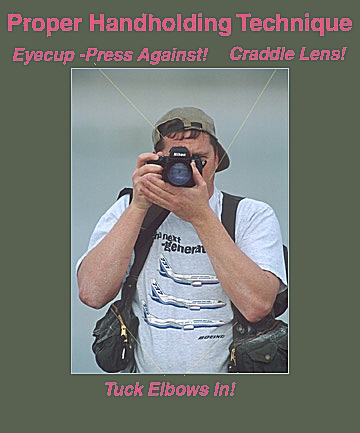Proper Technique for Wide
Angle & Telephoto Lenses
by B. Moose Peterson
 It's 1975 and I'm sitting in my high school photography class. My teacher was a genius, but of course being a teenager, I thought differently back then. I learned so much from him, including one lesson that wouldn't sink in for over a decade. I can still vividly picture him standing in the front of the class with his prized Nikon F Photomic with 105f2.5 lens, showing us how to properly handhold it to capture sharp images. I sat in the back of the class (my usual placement in all classes for obvious reasons) shaking my head and saying to myself, "what a waste of time." How little I knew! It's 1975 and I'm sitting in my high school photography class. My teacher was a genius, but of course being a teenager, I thought differently back then. I learned so much from him, including one lesson that wouldn't sink in for over a decade. I can still vividly picture him standing in the front of the class with his prized Nikon F Photomic with 105f2.5 lens, showing us how to properly handhold it to capture sharp images. I sat in the back of the class (my usual placement in all classes for obvious reasons) shaking my head and saying to myself, "what a waste of time." How little I knew!
Proper handholding technique is a must, a technique that must be second nature to you and your photography! This means you must practice, practice, practice, until you do it without thinking about it every time you pick up a camera to shoot. Personally, I pick up a camera every day and practice if I'm not out actually shooting in the field. Shooting with only the Nikon D1 now, I can check my results to make sure I'm using correct form by shooting at slow shutter speeds (1/15 and slower) and then looking at the LCD at my results. Proper handholding technique is real simple and it works like this.
First and foremost, there are no left or right-handed cameras. Everyone has to hold a camera the same way. You grab the camera with your right hand. The right hand holds the camera and the index finger fires off the shutter release (which needs to be accomplished by a smooth, soft push and not a jab!). The left hand CRADDLES the lens barrel! The lens needs to rest in the palm of your hand so gravity forces the lens down into your hand. This is imperative to proper handholding. Then you bring your elbows into your sides and rest them there. You don't squeeze so tight that you turn blue or your bellybutton pops out (nor hold your breath and slowly release it). Lastly, have an eyecup on your camera body, which you press against your forehead.
A tripod has three legs, which come to one point where you attach your camera. These three legs or three points of contact are what provide the needed support for your camera. Proper handholding technique accomplishes the same thing, creating three points of contact to provide a stable platform for your camera: your hands, your elbows and forehead. If you practice this technique every day, you will easily be able to hand hold a Nikon 80-400VR or Canon 100-400IS at 1/30 and capture sharp images WITHOUT the image stabilization turned on! The best investment you can make in your photography is improving your basic techniques and there is nothing more basic or important to success than proper handholding technique!
 Subscribe to
Vivid Light
Subscribe to
Vivid Light
Photography by email
|
|
Capture the sharpest possible image by improving the person behind the
camera
Roll your finger when firing!
Take the
gear out and practice so you don't have to think about it when you're
out shooting
|